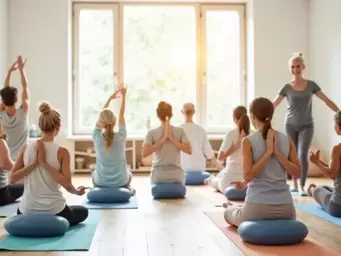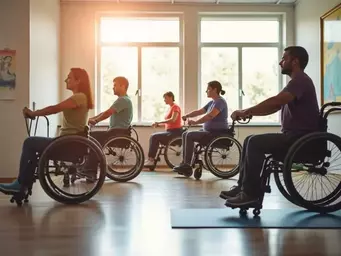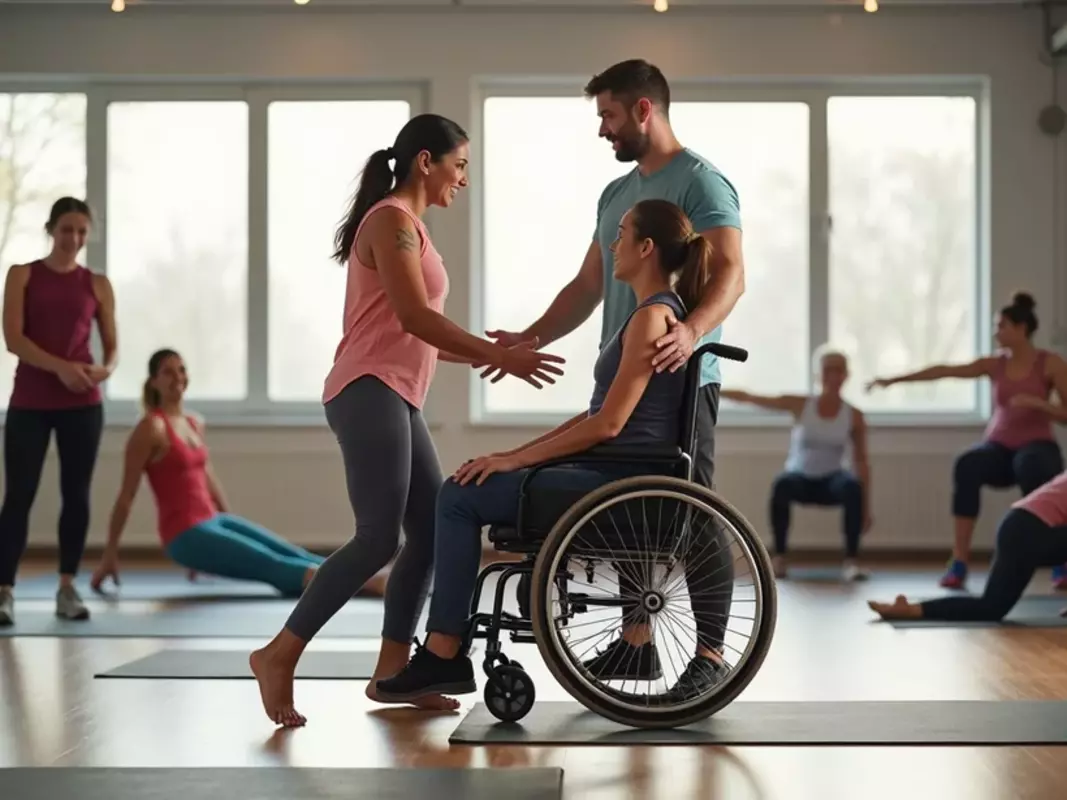NDIS Goals Through Movement Programs

Did you know that personalized movement programs can significantly enhance the quality of life for individuals participating in the NDIS? By aligning physical activity with personal goals, these programs empower participants to achieve greater independence and well-being.
What You Will Learn
- Understanding the importance of NDIS goals in enhancing the quality of life for participants.
- How tailored movement programs can improve physical health, emotional well-being, and social skills.
- The role of exercise physiologists in creating personalized exercise plans that reflect individual needs and goals.
- The benefits of integrating specialized therapy techniques like aquatic therapy and yoga into movement programs.
- The collaborative role of allied health professionals in designing effective and holistic movement programs.
- How support coordinators facilitate access to movement programs, ensuring participants achieve their goals.
- Steps to get started with personalized movement programs tailored to unique needs and aspirations.
Key Benefits of Movement Programs for NDIS Goals
Integrating movement programs into NDIS plans offers numerous advantages that enhance the quality of life for participants. Below is a visual representation of these benefits.
Personalization
Movement programs are tailored to meet the unique needs of each participant, ensuring they are both effective and engaging. For a deeper dive into how exercise physiology supports NDIS goals, consider reading about NDIS and Exercise Physiology Insights.
Improved Outcomes
Regular participation in these programs can lead to better physical capabilities and increased independence.
Holistic Approach
Beyond physical fitness, movement programs also support emotional and cognitive aspects, promoting overall well-being.
Community Engagement
These programs often encourage social interaction, helping participants build valuable connections.
Understanding the Role of Movement Programs in Achieving NDIS Goals
When we talk about the NDIS, or the National Disability Insurance Scheme, it’s essential to understand the *role of movement programs* in reaching individual goals. These goals are tailored to the unique needs of each participant, and having a clear understanding of them can make a huge difference in achieving positive outcomes. Together, we can explore how *movement programs* play a critical role in this journey, helping individuals with disabilities thrive.
At Health Moves, we believe that understanding the intersection between NDIS goals and movement programs is vital. This foundation allows us to craft tailored movement solutions that not only meet NDIS requirements but also resonate with the personal aspirations of our clients and their families.
Defining NDIS Goals and Movement Programs
Let's start with NDIS goals. These goals are personalized targets designed to improve a participant's overall quality of life. They can include aspects like enhancing mobility, increasing independence, or improving social skills. The significance of these goals cannot be overstated; they guide the support participants receive, ensuring it aligns with their individual needs and aspirations. To learn more about how exercise physiologists contribute, check out our guide on Exercise Physiologists in NDIS Explained.
So, what are movement programs? In simple terms, they are structured plans that incorporate physical activities tailored to meet the specific needs of individuals with disabilities. These programs can include a wide range of activities, from gentle stretching to more intense workouts, all aimed at enhancing physical capability and promoting emotional well-being.
- Improve physical health and fitness
- Enhance social skills through group activities
- Build confidence and independence
- Support emotional and mental well-being
Overview of NDIS Goals and Their Importance
NDIS goals are vital because they serve as a roadmap for participants, guiding them through their journey towards greater independence. Achieving these goals can lead to significant improvements in various aspects of life, including health, relationships, and overall happiness. Each goal is unique, reflecting the individual’s desires and circumstances, which is why it's crucial to keep them at the forefront of any movement program.
At Health Moves, we help participants articulate these goals in a way that resonates with their personal experiences. This collaborative approach ensures that movement programs are not only effective but also empowering.
What Are Movement Programs?
Movement programs are comprehensive plans that combine exercise with therapeutic techniques designed specifically for people with disabilities. They are more than just physical activities; they are crafted to meet specific goals while considering the individual’s abilities and limitations. The beauty of movement programs lies in their adaptability—the same program can be adjusted to suit different needs and preferences.
These programs often include activities like:
- Strength training
- Balance exercises
- Coordination drills
- Aerobic exercises
By focusing on tailored movement, participants can experience improved physical health and emotional well-being, bringing them closer to achieving their NDIS goals. For more detailed information on structuring these programs, read about Building Movement Programs for Disabilities.
The Impact of Exercise Physiology on NDIS Outcomes
Exercise physiology plays a significant role in enhancing NDIS outcomes. By utilizing scientific principles, exercise physiologists can create personalized exercise plans that focus on the participant's unique strengths and challenges. These plans not only promote physical fitness but also contribute to achieving broader NDIS goals.
At Health Moves, we pride ourselves on our evidence-based approach, ensuring that every movement program is rooted in sound principles. This commitment translates into real, measurable outcomes for our clients.
Personalized Exercise Plans for NDIS Participants
Creating a personalized exercise plan involves a deep understanding of the participant's needs, preferences, and goals. This tailored approach can lead to remarkable results, such as:
- Increased strength and endurance
- Improved mobility and functional movement
- Better overall health and wellness
When participants engage in a program that resonates with their interests, motivation increases. This is why we focus on activities that not only meet their physical goals but also bring joy and fulfillment.
Specialized Therapy Techniques and Their Benefits
Integrating specialized therapy techniques into movement programs can enhance physical and emotional outcomes. Techniques like aquatic therapy, resistance training, and yoga can be particularly beneficial in promoting accessibility and fun during exercise.
Some of the key benefits of these specialized therapies include:
- Reduced risk of injury
- Enhanced flexibility and range of motion
- Support for mental health through stress relief
By embracing various therapeutic methods, we at Health Moves strive to create an inclusive environment that fosters growth, happiness, and independence for every participant.
Role of Allied Health Professionals in Movement Programs
Allied health professionals, such as exercise physiologists, physiotherapists, and occupational therapists, play a crucial role in designing and implementing movement programs. Collaboration among these professionals ensures that participants receive holistic support tailored to their specific needs.
Through this teamwork, participants have access to a wealth of knowledge and expertise, which can greatly enhance the effectiveness of their movement programs. For detailed information on the NDIS and exercise physiology, see our NDIS and Exercise Physiology Insights.
Collaboration Between Physiotherapy and Occupational Therapy
Collaboration between physiotherapy and occupational therapy can lead to more comprehensive movement programs. While physiotherapists focus on physical rehabilitation, occupational therapists emphasize functional skills needed for daily life. This combination results in a well-rounded approach that supports overall well-being and independence.
- Enhancing mobility and strength.
- Developing skills for everyday activities.
- Improving overall quality of life.
Importance of Support Coordinators in Implementing Movement Programs
Support coordinators are key players in the NDIS landscape. They help bridge the gap between participants and the various services they require, including movement programs. Their role is vital in ensuring that participants access the right resources and support to achieve their goals.
By working closely with exercise physiologists and other allied health professionals, support coordinators can facilitate a smoother path for participants to achieve their desired outcomes.
Pro Tip
Did you know? Incorporating a variety of movement activities into your program can significantly enhance engagement and motivation. Try mixing different forms of exercise—like strength training, yoga, and group sports—to keep things fresh and enjoyable. This variety not only helps maintain interest but also promotes overall physical and mental well-being.
Summarizing the Benefits of Movement Programs for NDIS Goals
At Health Moves, we recognize that movement programs play a crucial role in helping individuals achieve their NDIS goals. These programs not only promote physical health but also enhance overall well-being, creating a more fulfilling life experience. Here’s a quick recap of some key insights about the benefits of integrating movement programs into NDIS plans:
- Personalization: Movement programs are tailored to meet the unique needs of each participant, ensuring they are both effective and engaging.
- Improved Outcomes: Regular participation in these programs can lead to better physical capabilities and increased independence.
- Holistic Approach: Beyond physical fitness, movement programs also support emotional and cognitive aspects, promoting overall well-being.
- Community Engagement: These programs often encourage social interaction, helping participants build valuable connections.
Understanding how movement programs align with NDIS goals allows families and participants to focus on the positive outcomes of their journey. It’s about empowering individuals with the tools they need to thrive!
Encouraging Next Steps Towards Achieving NDIS Goals
How to Get Started with Personalized Movement Programs
Are you ready to take the next step in achieving your NDIS goals? Getting started with personalized movement programs can be both exciting and rewarding. Here’s how you can begin:
- Reach Out for Support: Contact a qualified Exercise Physiologist at Health Moves to discuss your unique needs and goals.
- Participate in an Assessment: Undergo a comprehensive assessment to develop a tailored program that suits your physical and emotional requirements.
- Set Clear Goals: Work together to set specific, measurable, achievable, relevant, and time-bound (SMART) goals to track your progress.
- Engage in Regular Sessions: Commit to attending your scheduled sessions consistently to maximize benefits.
Remember, every small step contributes to your growth and achievement. Don’t hesitate to reach out for help! You’re not alone on this journey.
Frequently Asked Questions About NDIS and Movement Programs
Common Queries Addressed for Clarity and Understanding
It’s common to have questions about how NDIS and movement programs work together. Here are some frequently asked questions that may provide clarity:
- What is the main goal of a movement program? The primary goal is to enhance physical abilities and promote a healthier lifestyle.
- How do I know if I am eligible for funding? Eligibility depends on your individual circumstances; consulting with a support coordinator can provide guidance.
- Can my family participate in the movement programs? Yes! Family involvement can enhance motivation and create a supportive environment.
- How do I measure my progress? Regular assessments and feedback from your exercise physiologist will help track your achievements.
At Health Moves, we’re here to help you navigate these questions and provide the support you need to succeed. Don’t hesitate to reach out with your inquiries—your journey matters to us! For more information on tailored exercise, explore our resources on Exercise Programs for NDIS Participants.
Recap of Key Points
Here is a quick recap of the important points discussed in the article:
- Understanding NDIS Goals: NDIS goals are personalized targets aimed at improving quality of life, including mobility, independence, and social skills.
- Importance of Movement Programs: These structured plans focus on physical activities tailored to individual needs, promoting better health and emotional well-being.
- Role of Exercise Physiology: Exercise physiologists create personalized exercise plans that enhance physical capabilities and support broader NDIS goals.
- Integration of Therapy Techniques: Specialized therapies like aquatic therapy and yoga provide additional benefits, including reduced injury risk and improved mental health.
- Collaboration Among Professionals: Allied health professionals work together to design comprehensive movement programs that address both physical and functional needs.
- Support Coordinators' Role: They help participants access necessary resources and support to achieve their movement program goals.






